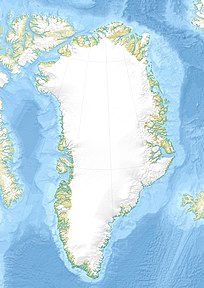Nuussuaq (Uummannaq)
| Nuussuaq (great cape) | ||
|---|---|---|
| Nûgssuaĸ | ||
| Commune | Avannaata Communia | |
| District | Uummannaq | |
| Geographical location | 70 ° 41 '16 " N , 54 ° 34' 50" W | |
|
|
||
| Residents | 0 (1939) |
|
| founding | 1758/1799/1825 | |
| Time zone | UTC-3 | |
Nuussuaq [ ˈnuːsːuɑq ] (according to the old spelling Nûgssuaĸ ) is a deserted Greenlandic settlement in the district of Uummannaq in the Avannaata Kommunia .
location
Nuussuaq is located at the end of the large peninsula of the same name , which forms the border between the districts of Uummannaq and Ilulissat or Qeqertarsuaq . In front of Nuussuaq there are several small islands that form the continuations of the narrow capes in the area. The closest still inhabited place is Niaqornat 34 km east-northeast. In the other direction, Saqqaq is the next town 124 km southeast.
history
Nuussuaq as a colony
Nuussuaq was inhabited before the colonial era. In 1758 Johan Henrik Bruun founded a colony in Nuussuaq. As early as 1761 it was decided to move the colony and in 1763 Nuussuaq was given up and the colony was built in Uummannaq . It can be assumed that Nuussuaq was subsequently uninhabited.
In Nuussuaq there is a stone building of unknown origin, which has been described by various researchers as early as the 19th century. According to legend, it was built by a Greenland legendary hero, possibly Kaassassuk . It may have been built by hibernating whalers, but it is more likely a medieval building made by the Grænlendingar who passed here on their travels.
Nuussuaq as an attachment
It was not until 1794 that a yarn catching experiment was set up in Nuussuaq, which ran via the Ritenbenk colony . The hunt was extremely successful and in 1798 there were already 56 people in Nuussuaq. In the same year a whale was caught for the first time. After the attempt was successful, a trading and whaling facility was established in Nuussuaq in 1799. An assistant, a carpenter, a cooper, a whaling ladder and a sailor were employed and a multi-story building was built. The economic situation was so good that consideration was given to giving Nuussuaq back colonial status and making Upernavik a part of it. Instead, the Nuussuaq plant was incorporated into the colonial district of Uummannaq in 1804. Whaling decreased, but seal hunting allowed the facility to survive. During the war, the facility was abandoned in 1810 and the population moved away. In the summer a Dane guarded the buildings, but the place was sacked by English whalers in 1813 and 1815. A Danish ship then picked up everything that could still be found in the village. In 1818 the multi-storey building was also to be removed for use elsewhere, but the English had already destroyed it and set it on fire.
Nuussuaq as Udsted
In 1825 Nuussuaq was re-established as Udsted under Ritenbenk. In 1896 the place was reassigned to the colony in Uummannaq.
Nuussuaq became its own municipality in 1911, to which the Nuussuutaa residential area still belonged. The parish council consisted of three men. The municipality was part of the 8th district electoral council of North Greenland.
In 1915, 59 people lived in Nuussuaq. There were ten Greenlandic houses and one more Greenlandic house that served as a dwelling for the Udsteds administrator. It was 70 square meters and had two rooms and a kitchen. The provisions store from 1852 was a half-timbered building with wood paneling. There were also three bacon houses. One was a Greenlander house, the second half-timbered building with a wooden facade and wooden roof and the third a gray-painted half-timbered building with a concrete floor and roof shingles from 1915. The school chapel was moved to its position from 1874 and ten years later. That was also a half-timbered building with board cladding and roofing felt. It measured 41 m², had two rooms and a sermon chair, a harmonium and an altar. 17 hunters, the Udsteds administrator, a catechist and a midwife worked in the village. In 1930 Nuussuaq had 69 inhabitants, but in 1938 the place was abandoned.
List of colonial employees
The following sales assistants were entrusted with the management of the plant.
- 1794–1796: Jeppe Andreas Scheen
- 1796–1799: Niels Larsen Steenholdt
- 1799–1800: Severin Martinus von Cappelen
- 1800–1805: Niels Larsen Steenholdt
- 1805–1810: Jens Parelius Schade
Individual evidence
- ↑ Map with all official place names confirmed by Oqaasileriffik , provided by Asiaq
- ↑ a b c d e Alfred Bertelsen , Hother Ostermann : Beskrivelse af Distrikterne i Nordgrønland: Ũmánaĸ district. De grandson Bopladser. Nûgssuaĸ . In: Georg Carl Amdrup , Louis Bobé , Adolf Severin Jensen , Hans Peder Steensby (eds.): Grønland i tohundredeaaret for Hans Egedes landing (= Meddelelser om Grønland . Volume 60-61 ). tape 1 . C. A. Reitzel Boghandel, Copenhagen 1921, p. 392 ff . ( Digitized in the Internet Archive ).
- ↑ Jens Christian Madsen: Udsteder og bopladser i Grønland 1901-2000 . Atuagkat, 2009, ISBN 978-87-90133-76-4 , pp. 169 .
- ^ Hother Ostermann : Beskrivelse af Distrikterne i Nordgrønland: Ũmánaĸ District. History . In: Georg Carl Amdrup , Louis Bobé , Adolf Severin Jensen , Hans Peder Steensby (eds.): Grønland i tohundredeaaret for Hans Egedes landing (= Meddelelser om Grønland . Volume 60-61 ). tape 1 . C. A. Reitzel Boghandel, Copenhagen 1921, p. 381 f . ( Digitized in the Internet Archive ).

